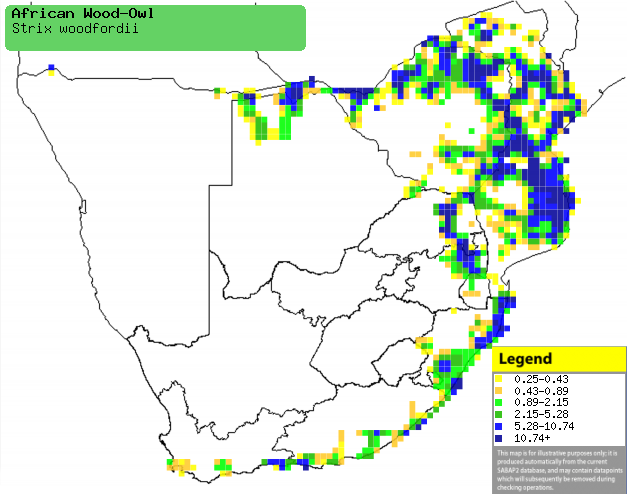|
Strix woodfordii (African
wood-owl)
Bosuil [Afrikaans]; Ibengwana [Xhosa]; uMabhengwane,
uNobathekeli [Zulu]; Kakuru (also applied to other owl species) [Kwangali]; Zizi
(generic name for owl) [Shona]; Mankhudu (also applied to Pearl-spotted owlet)
[Tsonga]; Lerubisana (applied to a number of other owl species) [Tswana];
Afrikaanse bosuil [Dutch]; Chouette africaine [French]; Woodfordkauz [German];
Coruja-da-floresta [Portuguese]
Life
> Eukaryotes >
Opisthokonta
> Metazoa (animals) >
Bilateria >
Deuterostomia > Chordata >
Craniata > Vertebrata (vertebrates) > Gnathostomata (jawed
vertebrates) > Teleostomi (teleost fish) > Osteichthyes (bony fish) > Class:
Sarcopterygii (lobe-finned
fish) > Stegocephalia (terrestrial
vertebrates) > Tetrapoda
(four-legged vertebrates) > Reptiliomorpha > Amniota >
Reptilia (reptiles) >
Romeriida > Diapsida > Archosauromorpha > Archosauria >
Dinosauria
(dinosaurs) > Saurischia > Theropoda (bipedal predatory dinosaurs) >
Coelurosauria > Maniraptora > Aves
(birds) >
Order: Strigiformes
> Family: Strigidae
The African wood-owl occurs across Africa south of the Sahel, occupying a variety of woodland and forest habitats. It mainly eats
insects and small birds, but it may also take snakes and small mammals. It
usually nests in tree hollows, which it uses repeatedly over multiple breeding
seasons, even if it gets flooded with water. It lays 1-3, usually 2 eggs, which
are incubated solely by the female for about 31 days, with the male doing all of
the hunting. The chicks are intensely cared for for the first week of their
lives, after which the female only visits the nest occasionally. They learn to
fly when they are about 50-60 days old, becoming fully independent a few months
later.
Distribution and habitat
Occurs across Africa south of the
Sahel, absent from areas of Somalia and Tanzania. In southern Africa, it is
locally common in the Caprivi Strip (Namibia), northern Botswana, Zimbabwe,
Mozambique, and eastern and southern South Africa. It can occupy almost any type
of dense forest, such as deciduous woodland, thick coastal bush and riparian or
evergreen forest, but it is also common in suburban gardens and parks.
|
 |
|
Distribution of African wood-owls in southern Africa,
based on statistical smoothing of the records from first SA Bird Atlas
Project (©
Animal Demography unit, University of
Cape Town; smoothing by Birgit Erni and Francesca Little). Colours range
from dark blue (most common) through to yellow (least common).
See here for the latest distribution
from the SABAP2. |
Predators and parasites
Food
Mainly eats insects and small birds, but it may catch take
snakes and small mammals. It usually hunts from a low perch, listening for any
sound that might indicate the presence of an animal. Once it hears or sees
something, it swoops down to the ground, grabbing its prey before returning to
the perch. It also catches bats or insects in flight, and
occasionally gleans insects from branches or leaves.
Breeding
- It usually nests in tree cavities, anywhere from 1-30
metres above ground; it also uses hollows in the ground among tree roots. It uses the same
nest repeatedly over multiple breeding seasons, even if it gets flooded with
water.
- Egg-laying season is from August-September, occasionally in other
months.
- It lays 1-3, usually two eggs, which are incubated solely by the female
for about 31 days, with the male doing all of the hunting.
- The chicks are cared for by both parents for the first week of their lives,
after which the female only visits the nest occasionally. The chicks stay in
the nest for about 30-37 days, leaving before they can fly. They scramble
around the surrounding bush for about three more weeks, at which point they
fledge, but they still remain dependent on their parents for about four more
months.
Threats
Not threatened, in fact its range has been increasing
recently, largely due to the abundance of wooded suburban gardens and parks.
References
-
Hockey PAR, Dean WRJ and Ryan PG (eds) 2005. Roberts
- Birds of southern Africa, VIIth ed. The Trustees of the John Voelcker
Bird Book Fund, Cape Town.
|
